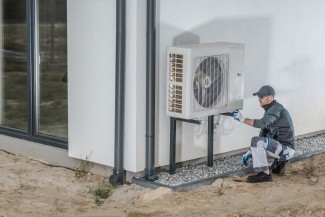Utility energy efficiency programs have a proven record of saving energy and money, but here’s an uncomfortable truth: They aren’t yet up to the immense challenge of the climate crisis. Amid a rapid rise in renewable power generation and in technology enabling demand flexibility, it’s time to restructure these efficiency efforts. Utilities need to scale these programs up and focus them on doing their vital part to reduce greenhouse gas emissions.
While we’re excited to see that 48 utilities have set goals of net-zero carbon emissions by 2050, few are currently making the investment decisions needed to get there, and even fewer are maximizing the emissions reductions possible from their energy-saving efforts. Meeting these goals will require an industry transformation: reforms to the utility business model, shifts in how utilities measure energy-saving progress, and new ways for regulators to prioritize approaches that reduce emissions.
With support from the Department of Energy, Pacific Northwest National Laboratory, and six major utilities and program administrators, we are launching our Climate-Forward Efficiency initiative today to engage stakeholders across the industry to create a roadmap for this transformation.
The shifting landscape of utility energy efficiency
Utilities’ programs to help customers improve energy efficiency have traditionally been designed to save a single resource, usually energy, typically measured in kWh or therms. But as the electric grid gets cleaner, technologies using electricity instead of burning fossil fuels in the home—like electric heat pumps—will increasingly be the lowest-carbon choice for heating a home and the water in it. Further, not all kWh are created equal; saving a kWh produced at a time of day or year when the power grid is drawing heavily from coal plants will do far more to reduce greenhouse gas (GHG) emissions than saving it at a time where there is excess solar power, for instance. As we see adoption of a wider range of resources, such as solar and wind, utilities will need to be able to measure and capture efficiency investments that save energy at the times most valuable for reducing GHG from power generation.
Utility clean energy programs designed to save energy in kWh or therms are missing important decarbonization opportunities through flexibility and fuel switching. For example, a household that uses gas heating could save more GHG—and sometimes more energy and money—by switching to a heat pump instead of a gas furnace with improved efficiency. Yet in many states they may not even have that option available to them in utility programs. And without regulatory changes to value flexibility in rates, planning, and cost-effectiveness testing, they might not have the opportunity to manage their thermostat or HVAC system to save money by using it at times of day when the grid has more and cheaper electricity available. Funds for energy efficiency are limited, and utilities are making investment decisions using policy frameworks that don’t prioritize greenhouse gas reductions, community resilience to climate change, or equitable outcomes for communities that will be hardest hit by the effects of climate change.
Beyond the need to redefine success and realign utilities’ efficiency program portfolios, we need a massive increase in investments in those portfolios to achieve climate goals, like the Biden administration’s commitment to carbon-free electricity by 2035 and 100% carbon-free or net-zero electricity goals in 16 states. At the current rate of progress, it will take approximately 500 years to complete whole-building retrofits on all residences (homes and apartments) and more than 60 years to retrofit all commercial buildings. Utility and state efficiency programs have an infrastructure of trade allies (contractors, retailers, and manufacturers) and a workforce that’s ready to expand to meet this need.
Emerging emphasis on decarbonization in state and utility practices
In recent years, some states and utilities have begun to tackle these challenges, making changes to the policies that govern efficiency programs and to the programs themselves. Some states and utilities are starting to measure success using fuel-neutral metrics (energy savings or GHG), and some are bringing the time value of energy efficiency into cost effectiveness calculations and goals. And some states are starting to change the rules governing whether efficiency programs can encourage customers to switch from one fuel source to another, such as from a gas furnace to an electric heat pump. These changes allow ratepayers to invest in low-carbon fuel-switching measures and orient utility goals toward reducing greenhouse gas emissions.
It is important to note that most states are also maintaining electricity savings targets as well. They are crucial for spurring home-sealing upgrades that enable and support electrification and are needed to meet long-term carbon goals and support customer resilience to winter reliability constraints. We do not want utilities just promoting electric vehicles and ignoring other key opportunities to reduce emissions.
ACEEE has set the ground for this initiative by researching emerging policy and program innovations for maximizing GHG reductions from efficiency. We profiled leading states taking innovative approaches with their energy efficiency resource standards, examined how states are adopting performance incentive mechanisms to encourage utilities to deliver energy savings at targeted times, and highlighted how efficiency and demand response and efficiency, solar, and storage can be bundled together in utility programs.
While our research efforts and engagement have identified leading states and utilities taking important first steps, the overwhelming bulk of this transformation remains ahead of us.
Reimagining efficiency programs with our new Climate-Forward Efficiency initiative
With our new Climate-Forward Efficiency initiative, our research will dig deeper into the misalignments facing utility portfolios—why we need to shift our practices—and how to do it to meet climate and affordability challenges. To understand why we need to shift our practices, we will explore the lessons learned and tradeoffs from early leaders taking steps to maximize GHG reductions from their efficiency portfolios. That research will identify best practices and options for changing definitions of efficiency and metrics for success to spur the most effective customer offerings for reducing GHG.
Changing definitions and goals will be insufficient; this shift will require changes across energy efficiency business practices. The evolution in business-as-usual energy efficiency will require action not only from utilities and their regulators, but from program implementers, trade allies, consumer advocates, and community-based organizations.
Working with stakeholders, we will conduct a series of workshops and interviews to develop a roadmap for utilities and regulators to reengineer their efficiency programs, policies, pricing, and procurement to align with the climate challenge, and we will provide technical assistance to facilitate the transformation. We have no time to waste.
Interested in learning more or joining the Climate-Forward Efficiency initiative? Please complete this survey to be kept up to date on the initiative and ways to be involved. And please contact Mike Specian if you have questions about the initiative.
The initiative’s forthcoming roadmap is generously supported by the U.S. Department of Energy’s Building Technologies Office, Pacific Northwest National Laboratory, U.S. Environmental Protection Agency, ComEd, Con Edison, Eversource, LADWP, National Grid, and United Illuminating, with input from the Energy Trust of Oregon.

